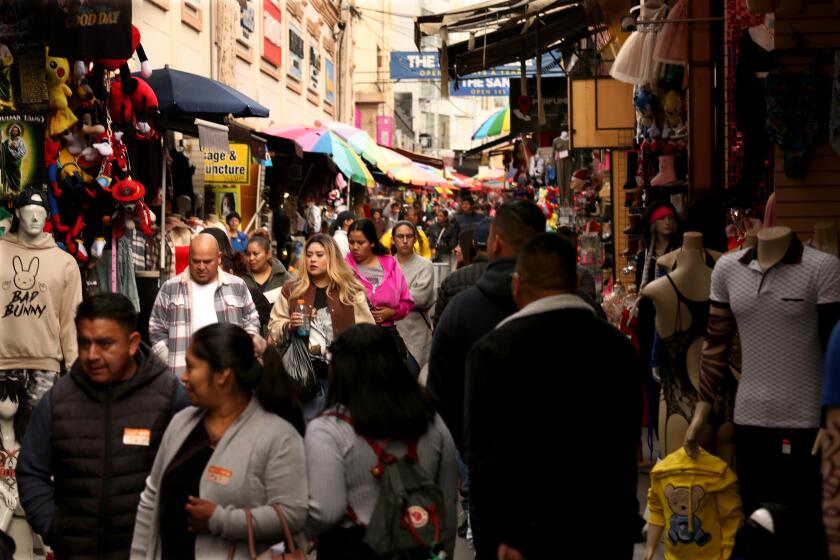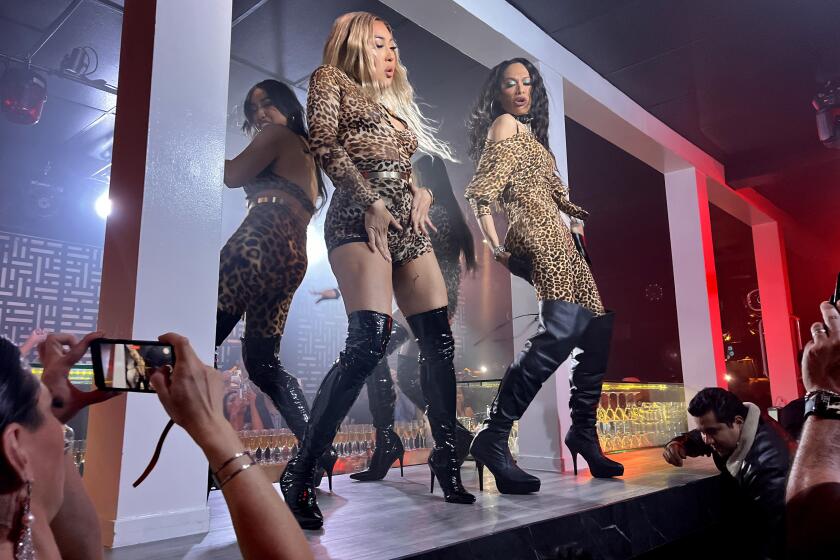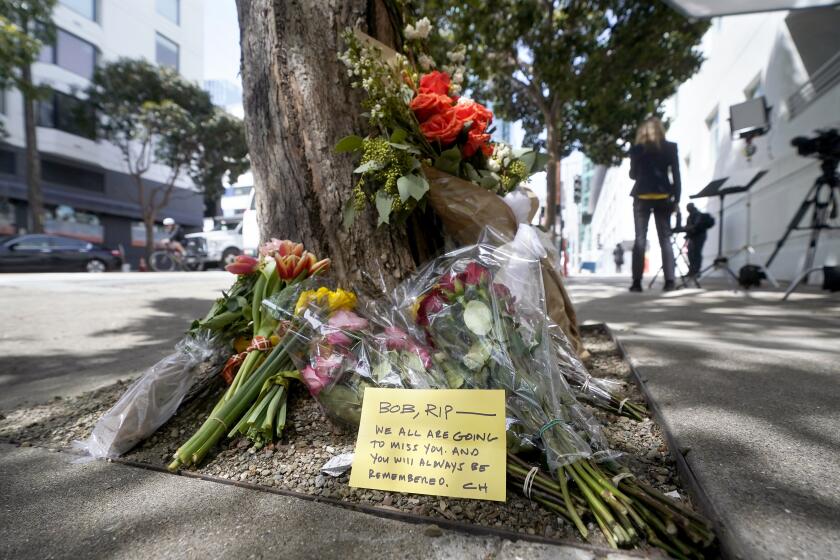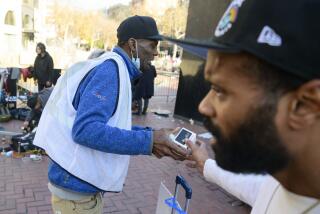Is there a retail exodus in San Francisco? Some say Union Square is ‘beating strong’
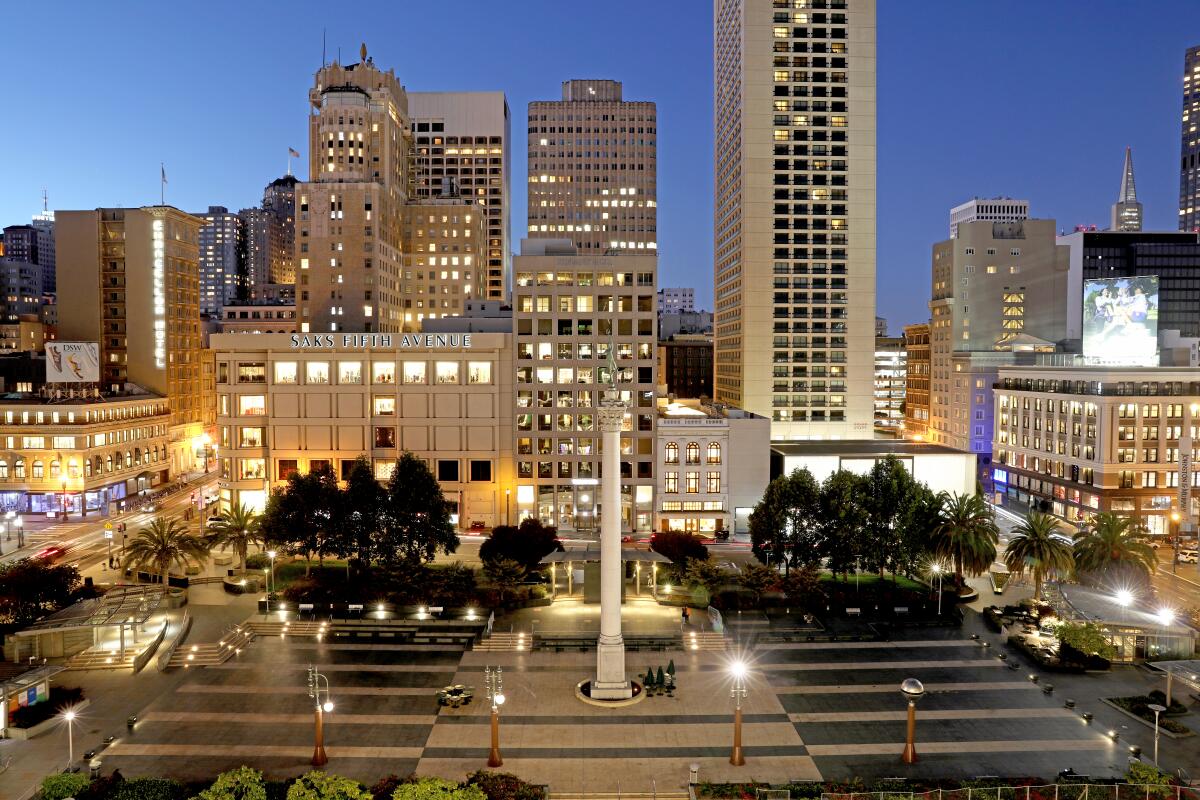
- Share via
Is Union Square in downtown San Francisco really dying?
Nordstrom is shutting down its two stores in the area. Saks Off 5th is leaving. T-Mobile already closed its two-level flagship store.
So why are these retailers in Union Square or near it saying goodbye to a well-known tourist destination and the heart of the city’s shopping core? The exodus of these business has concerned some business leaders and economists alike.
Reductions in consumer spending, disruptions in the supply chain, high operation costs and public safety have led the overall retail vacancy rate in San Francisco to rise to 6% in the first quarter of 2023 — up from 5.2% a year ago and the highest in the city since 2006, according to data from Cushman and Wakefield, a commercial real estate services firm.
The overall vacancy rate in Union Square went up to 15.5% in the first quarter of 2023, up from 14.2% in the last quarter of 2022.
“It’s a very serious problem for the whole city, much less downtown,” said Jeff Bellisario, executive director of the Bay Area Council Economic Institute.
California’s downtowns have had varying levels of success in rebounding from pandemic shutdowns — while San Diego has almost fully recovered, San Francisco is concerned about a potential ‘doom loop.’
But Mayor London Breed and other San Franciscans have pushed back against the narrative in recent media coverage that Union Square is doomed.
“Those folks who don’t walk the streets in San Francisco, that don’t live in San Francisco, but they want to write about and commentate about San Francisco, I challenge you to come to this city and see what it feels like,” Breed said during a May 16 news conference. “I challenge you to come shop at the stores that you’re complaining about, which you probably never even stepped foot in in the first place.”
Breed emphasized that media outlets aren’t covering the stores, such as Banana Republic and Ikea, that have moved or are planning to move into Union Square.
At least 26 stores have closed in downtown San Francisco since 2020, with seven more slated to shut down.
This month, Nordstrom announced that it would close its two stores on Fifth and Market streets, becoming the latest retailer to leave Union Square in the last few years.
“The dynamics of the downtown San Francisco market have changed dramatically over the past several years, impacting customer foot traffic to our stores and our ability to operate successfully,” Jamie Nordstrom, the chief stores officer, said in a statement.
The far-right loves to paint San Francisco as a crime-ridden ‘hellhole.’ The celebration of an iconic transgender club is a reminder of what the city is really about.
Saks Off 5th on Market Street is also shutting its doors, attributing the decision in a statement to “store performance and other factors.”
As for T-Mobile’s recent closure at Stockton Street, a spokesperson said it was part of the company’s “nationwide retail strategy to better take care of customers.”
Despite those businesses moving, Breed held a news conference a couple of weeks ago with District 3 Supervisor Aaron Peskin to announce a $6-million investment into the three blocks of Powell Street near Union Square where H&M, Gap and Uniqlo have closed their doors in recent years.
While Marisa Rodriguez, the CEO of Union Square Alliance, acknowledged that certainly some stores have left Union Square during and after the pandemic, she emphasized that luxury retailers in particular have expanded, opened or moved to the area.
“The heart of the square is beating strong — it’s alive,” she said. “There certainly have been challenges postpandemic that a lot of major cities have been experiencing. We are trying to position ourselves to meet the moment and pivot where we can.”
San Franciscos urban problems are a challenge; they are also an opportunity. Plus, Tchaikovsky orgasms and a 23-year-old apology, in our weekly arts newsletter
Saint Laurent, Chanel and Van Cleef & Arpels have all moved to Union Square, while Pandora opened its doors there last year.
“When we shut down, we shut down pretty hard,” Rodriguez said. “Union Square is a visitor destination. We’re gonna see more closures than you would in a more traditional neighborhood setting where people can pivot and shop where they live. A lot of these closures are a result of not being able to survive that shutdown.”
Storefronts in the shopping district have been emptying out in recent years due to the rise of internet shopping coupled with a reduction of foot traffic in the aftermath of the pandemic, according to Wade Rose, president of Advance SF, a business advocacy group.
“This is an example of the pressure urban retail has been feeling as a result of how people buy things,” Rose said. “San Francisco is deeply engaged and dealing with that issue. There are roughly 300,000 less people in downtown San Francisco than there was in 2019.”
The city’s property crime and homelessness crisis have also deterred foot traffic, Rose said.
The stabbing death of Cash App founder Bob Lee this week has sparked fears from residents and tech industry leaders alike over crime rates in San Francisco.
San Francisco has the highest property crime rate in the state, rising by 16.9% in 2021, according to the California Department of Justice’s Criminal Justice Statistics Center.
The Bay Area has the highest rate of property crime in the state, with a rate of 2,718 incidents per 100,000 residents.
Reported incidents of commercial burglary have actually decreased in San Francisco, according to data from the San Francisco Police Department. In 2020, there were 1,107 incidents, compared with 945 in 2021 and 735 in 2022.
Rose referred to San Francisco’s Stonestown Mall as a shopping district pivoting to meet the needs of a population. The mall, he said, which was once very traditional and included a Macy’s, fell on hard times and had to be reinvented. It now has a Trader Joe’s, a Sports Basement and a Target.
“It’s thriving because it meets the needs of the neighborhood and has the type of metamorphosis that needs to happen in the downtown retail district,” he said. “It’s not only Union Square that’s under pressure because of these issues.”
The state’s major cities lost people between 2020 and 2022, especially in Northern California. But exurban boomtowns, including some Southern California areas, saw gains.
Union Square, among other shopping districts, will need to diversity and add a variety of shopping and living experiences in order to attract consumers.
“The bottom line is that San Francisco’s urban core must become a much more experientially diverse place and a physically diverse space than what it is as a result of recovery from the Great Recession,” Rose said. “What that means is that there should be a 24/7 city, there should be more cultural amenities, and there should be diverse types of retail and businesses.”
More to Read
Sign up for Essential California
The most important California stories and recommendations in your inbox every morning.
You may occasionally receive promotional content from the Los Angeles Times.
